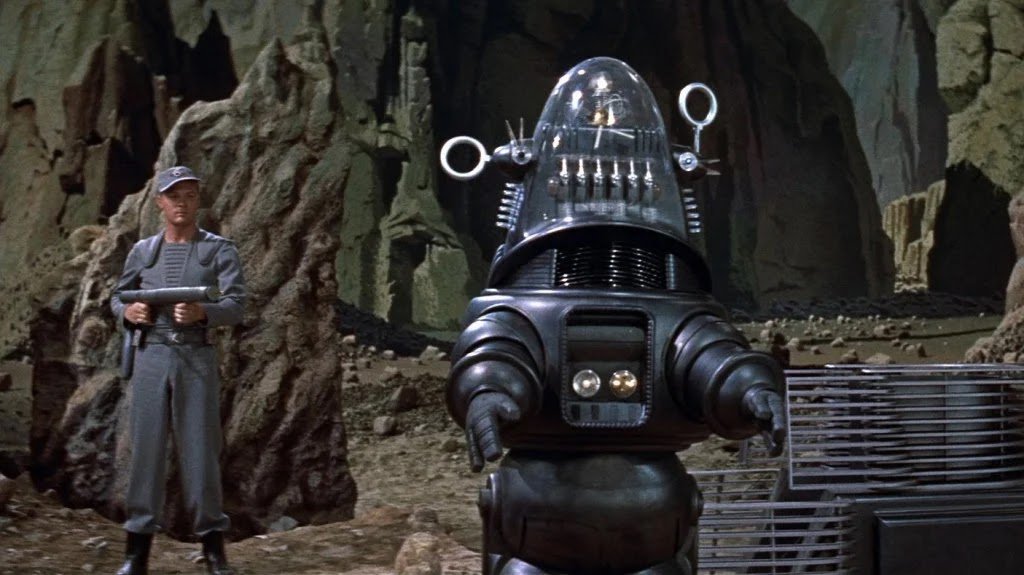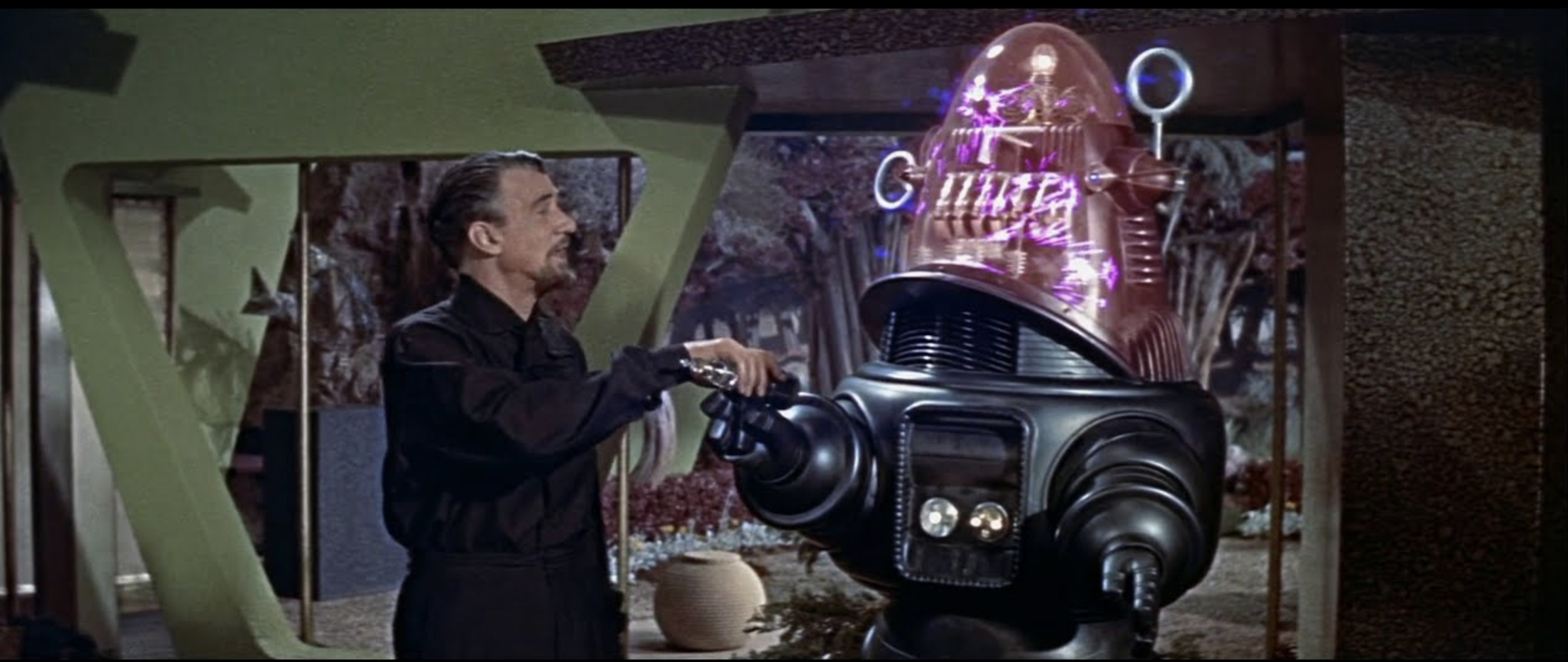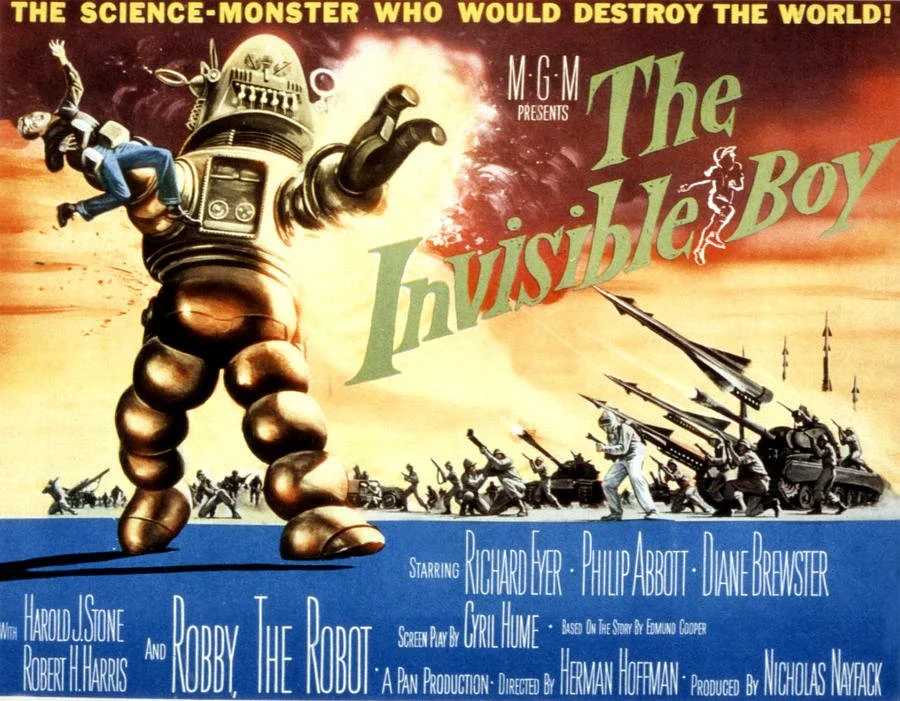Artificial Bodies, Artificial Lives: Introducing Robby the Robot
by Tessa Swehla, Staff Writer
It seems odd, given the turmoil I described in my last entry, that the 1950s saw both a contraction in science fiction film production and a reinvigoration of the genre in terms of its cinematic potential. Some of the best and most influential sci-fi films were made in the ‘50s despite the rise of TV and McCarthyism. Fred M. Wilcox’s Forbidden Planet (1956) is a prime example of the giant strides forward in production design as well as storytelling potential.
There were several other real world factors at play as well. The space race had officially kicked off the year before when the US announced its plans to launch satellites into orbit. The competition captured the public’s imagination, and space stories became extremely popular. Forbidden Planet capitalizes on this by being the first sci-fi film to feature faster than light travel as well as depicting the colonization of other planets by humans. It was also the first film to utilize an entirely electric soundtrack (created by cybernetics aficionados Bebe and Louis Barron), featuring otherworldly noises and blurring the lines between score and sound effects. The film pushed sci-fi forward, challenging what was possible in production design.
Forbidden Planet is a loose adaptation of The Tempest, with the titular planet taking the place of an island and technology taking on the role of magic. Commander John J. Adams (Leslie Nielsen) and his crew aboard the United Planets starship C-57D arrive at the planet Altair IV to investigate what happened to a previous expedition to the planet. They find only two survivors–Dr. Morbius (Walter Pidgeon) and his daughter Altaira “Alta” (Anne Francis)–and a mystery that threatens the whole crew. The film also gives us a new icon in Robby the Robot, who was such a central part of the film’s marketing that the film’s credits introduce him as if he was a member of the cast. Morbius tells his visitors that he created Robby based on designs left by the previous civilization on the planet, and Robby essentially occupies the role of Morbius’ servant and Alta’s caretaker.
Created by such members of the MGM prop department as Arnold Gillespie and Robert Kinoshita, Robby is another leap forward in android design. Robby’s glass egg-shaped dome filled with complex moving machinery is almost steampunk in its intricacy. His blue light up audio display, his bubble legs, and his whirling circular antennae mix the android design elements with the “tin can” elements of other contemporary film robots. While at first you may think that Robby doesn’t qualify under my definition of android–after all, all the androids I’ve written about so far have more human looking faces–his design is still roughly humanoid with a body, legs, and arms. Even his audio display is in the area we typically think of as a mouth.
I’m sure there is a fascinating article to be written about how the human characters–and the audience members–anthropomorphize Robby based on a few spare familiar details, but the conclusion of such an article would be this: we want even our artificial companions, our tools, to be made in our own image. Searching Robby for some form of human expression is how we try to connect with him, because, at the end of the day, we are narcissistic creatures when it comes to our own form.
Robby was groundbreaking–and expensive. The suit, which consisted of rubber, metal, Plexiglass, and plastic, cost around $125,000, almost 7% of the film’s entire budget. Robby was operated by stuntmen Frankie Darro and Frankie Carpenter, both short actors (Darro was 5'3"). His voice was recorded post-production by actor Marvin Miller. Because all three actors were uncredited for the role, it allowed the studio to cast Robby as a personality, creating the fiction that Robby was real. As I mentioned previously, the opening credits of the film “introduce” Robby as playing himself: a convention usually reserved for first roles. Sure, the conceit is a bit of whimsy, but it also emphasizes the anthropomorphization of Robby, who is now an actor playing a part, on the same level as Nielsen or Francis.
Robby has two clear literary influences. The first is Ariel from The Tempest, a spirit enslaved to Prospero and the wizard’s main source of magic. Ariel’s function in the play is to enable various plot devices, initiating the titular storm and herding the various characters to where they need to be around the island. Ariel may not be mechanical by nature, but his seemingly unlimited powers provoke the same kind of wonder as Robby’s super strength or his built-in inexhaustible matter synthesizer, a forerunner to the synthesizers of Star Trek.
While Ariel is perhaps not the most devoted servant–constantly complaining and asking Prospero for his freedom–Robby’s other inspiration provides us with a more loyal example: Isaac Asimov’s 1940 short story “Robbie.” Asimov’s Robbie is a nanny, “constructed for one purpose really–to be the companion of a little child.” Unlike Robby, Robbie doesn’t speak, but he does play, safeguard, and care for his charge, even saving her from a dangerous industrial accident in the climax of the story. For Alta, Robby plays much of a similar role, taking the place of a nanny, confidant, and playmate (albeit one that makes new clothing instead of playing hide-and-seek.
“Robbie” is actually the first of Asimov’s robot stories, so he also introduced us to Asimov’s famous three laws of robotics, which summarized amount to:
Robots cannot harm or allow a human being to come to harm.
Robots must obey humans (unless the human’s orders conflict with the first law).
Robots must protect themselves (unless the protection comes at the expense of the first or second law).
Asimov’s laws transformed the way sci-fi writers and readers envisioned robots: they introduced the possibility that robots could be programmed to be “safe.”
And here-in lies Robby’s true contribution to sci-fi film. By bringing over Asimov’s literary ideas into the film tradition, Robby changed the way that androids could be written. No longer just unstable monsters or curiosities like the maschinenmensch or Olga, they could be safe and friendly, even silly, provided that safeguards like Asimov’s were in place. Morbius doesn’t go into specifics about the details of Robby’s safeguards, but what he does say sounds very much like a version of Asimov’s laws, ordering Robby to put his arm in a disintegrator beam to demonstrate his obedience (canceling the order before any harm is done). He then orders Robby to shoot Adams with his blaster, but Robby is paralyzed, “locked in a subelectronic dilemma between my direct orders and his basic inhibition against harming rational beings.” This demonstration makes Robby appear more as a companion (although Morbius insists that he is “simply a tool”) rather than a potential threat. After Asimov himself saw the film in the theater, he commented on how much he enjoyed seeing Robby adhere to the basic premise of his laws.
Robby also has a temperament and a flair for sarcasm. When Adams meets Robby, he attempts to make small talk about the high oxygen content of Altair IV. Robby actually responds with a dry observation about himself: “I rarely use it, sir. It promotes rust.” When Cook (Earl Holliman) asks Adams if Robby is male or female–again revealing a preoccupation with humanizing the machinery according to societal norms–Robby answers, “In my case, sir, the question is totally without meaning.” Later, Robby synthesizes gallons upon gallons of whiskey at Cook’s request, only to then get drunk with him. Depending on whether or not we categorize the Tin Man as an android or a cyborg, Robby is one of the first androids on film to have a personality beyond simple obedience or terrifying malfunction.
Robby’s primary function is to serve as physical labor in whatever capacity Dr. Morbius and Altaira need him to serve, but we see him most often performing tasks inside the house. Previously, our gynoids have mostly been sexual objects, but Robby–who insists that gender means nothing to him–takes on a more domestic role. When Morbius demonstrates Robby’s matter synthesizer ability to the astonished crewmembers, Adams exclaims that Robby is “a housewife’s dream.”
This coincides with another big cultural shift in the 1950s. As I mentioned in my last article, women were being forced back into the domestic sphere from their wartime jobs in the factories, but, as any woman who has kept house will tell you, domestic labor is often back-breaking, time consuming, and unpaid. Think about all the things that are necessary to keep that “perfect” 1950s American dream house. Meals must be prepared, every room kept spotless, company entertained, errands run, children fed and clothed, husband fed and clothed. Plus, the wife must be beautifully made up and accessible to her husband all the time. No wonder that the ‘50s also saw the rise of pharmaceuticals marketed to treat the depression and anxiety of housewives.
But I digress. Robby represents the other lucrative sector that corporations marketed to the overworked housewives: household technology. The first affordable automatic dishwasher was invented in 1950, for example. Frozen foods, microwaves, gas stove ranges, frost-free refrigerators, pre-sliced cheese, Saran wrap, and new kitchen appliances were all marketed for their “convenience” and “time-saving” attributes. For many, this huge advance in quality of life technology must have seemed like they were living in the future, and Robby is just an extension of this kind of commercialized domestic technology. He serves other roles in the film–including the pivotal one of making Adams realize that the incorporeal monster is rational because of Robby’s inability to harm it–but because he has been rendered a harmless tool by Asimov’s laws, his main function is in that domestic sphere, eliminating the need for a human woman for complete that labor.
Robby was so instantly popular that he made appearances across film and TV, including guest appearances on episodes of The Twilight Zone, Lost in Space, The Addams Family, The Man from U.N.C.L.E., and many, many more. These numerous guest spots caused one commentator to name him “the hardest working robot in Hollywood.” In The Invisible Boy, which came out a year after Forbidden Planet in 1957, Robby appears billed as himself once again, a money-grab by MGM to capitalize on Robby’s surprising popularity amongst audiences.
An adaptation of Edmund Cooper’s Saturday Evening Post short story “The Story of Timothy–The World’s Worst Problem Child,” the film bears no connection to Forbidden Planet whatsoever except Robby, whose appearance is explained by a vague gesture towards time travel. Nothing about this film evokes the technicolor philosophical spectacle of Planet: it is black-and-white, set in the 20th century and not the 23rd, and is more broadly comedic. Robby is once again voiced by Miller, and his look is generally the same as it is in the first film.
In The Invisible Boy, Dr. Tom Merrinoe (Philip Abbot) is having difficulty connecting with his ten-year-old son, the titular boy Timmie (Richard Eyer)–only metaphorically invisible at the beginning of the film. In an attempt to bond with him, he brings Timmie to his top secret lab project: a supercomputer designed to handle defense calculations for the military. The supercomputer manipulates Timmie into reassembling a robot left by a missing faculty member in his office: Robby. Robby becomes both Timmie’s playmate and the supercomputer’s unwitting pawn in a bid to take over Earth.
The film reveals new powers for Robby. Not only can he synthesize matter in this story, but he can also manipulate it, turning Timmie invisible at one point in the film. He also is revealed to be indestructible: at one point, the supercomputer–who has altered Robby’s base programming in order to allow him to harm humans and to obey its bidding–commands him to bring Timmie to a rocket that is scheduled to launch into Earth’s orbit. We watch Robby walk completely unharmed through a literal hail of bullets, missiles, and fire to reach his destination.
While The Invisible Boy is certainly not as influential or even as masterful as Forbidden Planet, it does address a lot of the ideas brought up in this column thus far. As in Forbidden Planet, Robby’s role in The Invisible Boy also falls into the domestic sphere, albeit in the role of child caretaker rather than household appliance–returning him closer to his literary counterpart Robbie. He constantly invents new and amusing toys or games for Timmie to play, including a kite that Timmie can use to fly, which scares Timmie’s mother (Diane Brewster).
Even here, we can see Asimov’s laws at work. When Tom attempts to spank Timmie near the end of the film (to punish him for the misdeed of being invisible in his parents’ bedroom as they attempt to have sex), Robby interrupts him, physically grabbing his arm to stop him. When asked why, Robby apologizes but reiterates that his programming will simply not allow a human to come to harm. This scene is played for laughs–a comedic catharsis–but it also re-establishes Robby as a “safe” android despite the part he was forced to play earlier in the film.
The first law is ultimately what defeats the supercomputer’s control of Robby as well. When the supercomputer commands Robby to torture Timmie to death (to gain his father’s compliance), Robby disobeys, freeing Timmie instead. Later, when the supercomputer threatens to eliminate every living thing on the planet, Robby destroys its hardware, effectively killing it.
This brings up an interesting line of questioning: why does Robby have Asmovian programming, but the supercomputer does not? Is this to illustrate once again the dangers of unfettered AI versus a limited android? Technically, both are embodied: Robby in his android casing and the supercomputer in its servers. But Robby is much more personal and sympathetic because we can see that anthropomorphisation in his form, whereas the supercomputer’s form is cold and unfamiliar. The only way to humanize the supercomputer is through its voice, which is no match for the funky and playful design of Robby. The supercomputer is only in it for its own survival and supremacy (convinced that humans will eventually destroy it, a topic I discussed in an article last month), whereas Robby is willing to be destroyed or dismantled for Timmie’s sake.
I’ve already written too much about Robby, but it is difficult to underestimate his impact on how androids were portrayed on film moving forward. Sure, filmmakers are still making plenty of films about the dangers of androids and AI, but we wouldn’t have C-3P0 or R2-D2 or Baymax or WALL-E without him. He occupies a beloved place amongst fans and still inspires storytellers to this day.
Next time: we will venture back into the realm of mad scientists and their cyborg creations with Island of Lost Souls (1932) and Guardians of the Galaxy Vol. 3 (2023).






